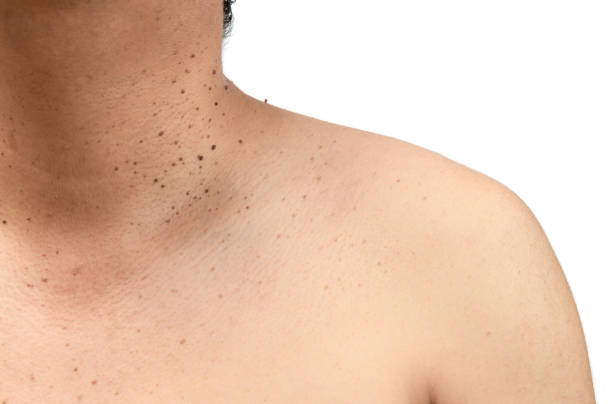
Table of Contents
Introduction to Skin Tag Removal
Skin tags are common benign skin growths that appear as delicate pieces hanging off the skin’s surface. They are generally harmless and painless, but their appearance can bother some. Skin tag removal is a common procedure to address cosmetic concerns or alleviate discomfort caused by skin tags. This article provides comprehensive information about skin tag removal, including at-home remedies, medical procedures, post-removal care, myths and misconceptions, and when to consult a dermatologist.
What are Skin Tags?
Skin tags, medically known as acrochordons, are small, soft growths that typically appear where the skin rubs against clothing or folds. They are composed of collagen fibres, blood vessels, and fat cells. Skin tags are usually flesh-coloured or slightly darker and range from a few millimetres to several centimetres. While they can develop anywhere on the body, they are commonly found on the neck, eyelids, underarms, groin, and breasts. Skin tags are harmless and noncancerous.

Causes and Risk Factors
The exact cause of skin tags is not fully understood, but certain factors may contribute to their development. Friction or constant rubbing of the skin against clothing or other skin surfaces is believed to play a role. Hormonal changes during pregnancy or in individuals with metabolic syndrome or insulin resistance may also increase the likelihood of developing skin tags. Additionally, genetic predisposition and obesity have been associated with a higher risk of skin tag formation.
Should You Remove Skin Tags?
The decision to remove skin tags is personal and depends on individual preferences. Skin tags are generally harmless and pose no significant health risks. However, some people remove them for cosmetic reasons or if they cause discomfort, irritation, or interfere with daily activities. It is important to note that self-diagnosis is not always accurate, and consulting a healthcare professional for a correct diagnosis is recommended before attempting any removal methods.
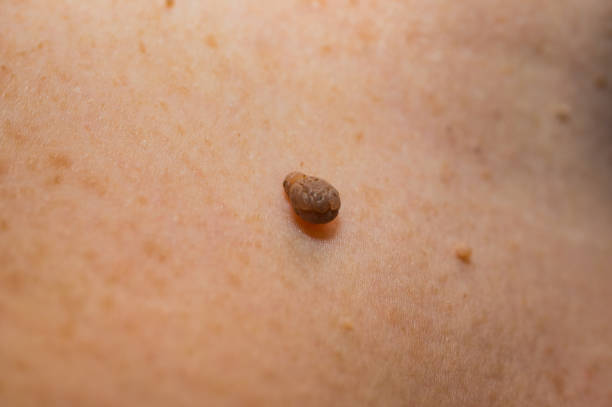
At-Home Skin Tag Removal Methods
While there are several at-home remedies for skin tag removal, it is essential to exercise caution and follow proper techniques to minimize the risk of complications. Here are some commonly used at-home methods:
Over-the-Counter Topical Treatments
Over-the-counter (OTC) topical treatments, such as creams, gels, or salicylic acid solutions, can be applied directly to the skin tags. These treatments work by gradually breaking down the skin tissue, causing the skin tags to shrink and eventually fall off. Carefully adhering to the instructions provided with the product and refraining from using it on sensitive areas or open wounds is crucial.
Tea Tree Oil
Tea tree oil, known for its antimicrobial and anti-inflammatory properties, is a popular natural remedy for various skin conditions, including skin tag removal. Applying diluted tea tree oil to the skin tags using a cotton ball or swab several times a day may help dry out and shrink the tags. Conducting a patch test before using tea tree oil is essential to identify any possible adverse reactions.
Apple Cider Vinegar
Apple cider vinegar is another commonly recommended natural remedy for skin tag removal. Soaking a cotton ball in diluted apple cider vinegar and applying it to the skin tags for several minutes several times a day is believed to help dissolve the tissue and cause the tags to fall off. However, it is crucial to approach apple cider vinegar cautiously, given its potential to elicit skin irritation in some people.
Dental Floss Tying Method
Tying dental floss involves securely fastening a clean piece of floss around the base of the skin tag. This technique cuts off the blood supply to the tag, leading to its eventual fall-off. It is crucial to ensure proper dental floss sterilization and tie it tightly enough without causing excessive pain or injury. This method should only be used on larger skin tags, and it is advisable to consult a healthcare professional before attempting this technique.

Essential Oils
Certain essential oils, such as oregano oil, frankincense oil, and lavender oil, are believed to possess properties that may aid in skin tag removal. Applying these oils can be done by directly placing them on the skin tags using a cotton ball or diluting them with a carrier oil before application. However, it is important to note that scientific evidence supporting their effectiveness is limited, and individual results may vary.
Medical Skin Tag Removal Procedures
For skin tags that are larger, located in sensitive areas, or causing significant discomfort, medical procedures performed by a healthcare professional may be necessary. Here are some common medical methods used for skin tag removal:
Electrosurgery
Electrosurgery, also known as electrocautery, uses a high-frequency electrical current to burn off the skin tags. This procedure requires local anesthesia to numb the area, and the electrical current effectively cuts off the blood supply to the tags while simultaneously sealing the wound. Electrosurgery is a safe and efficient method, but it may result in minor scarring or temporary redness.
Cryotherapy
Cryotherapy involves freezing the skin tags using liquid nitrogen or a specialized freezing kit. The extremely cold temperature destroys the cells within the tags, causing them to fall off over time. Cryotherapy is a procedure that is swift and causes minimal discomfort. Still, it may cause temporary skin discoloration or mild discomfort during the freezing process.
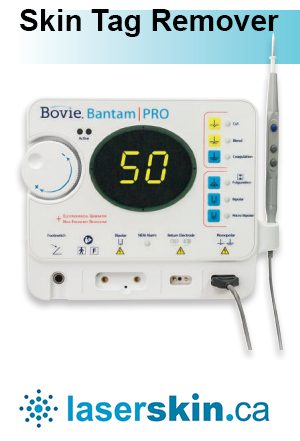
Cauterization
Cauterization involves using a heated instrument or chemical agent to burn off the skin tags. This technique effectively removes the tags while sealing the blood vessels to minimize bleeding. It is important to note that cautery should only be performed by trained healthcare professionals due to the risk of burns and scarring.
Ligation
Ligation, also referred to as strangulation, necessitates tightly binding a sterile thread or suture around the skin tag’s base to restrict blood flow. Over time, the tag shrinks and eventually falls off. Ligation is a safe and effective method, but it may cause temporary discomfort or irritation.
Excision
Excision is a surgical procedure that involves cutting the skin tags using a scalpel or surgical scissors. Local anesthesia is administered to numb the area before the removal. Excision is typically reserved for larger or stubborn tags and may leave a small scar after healing.
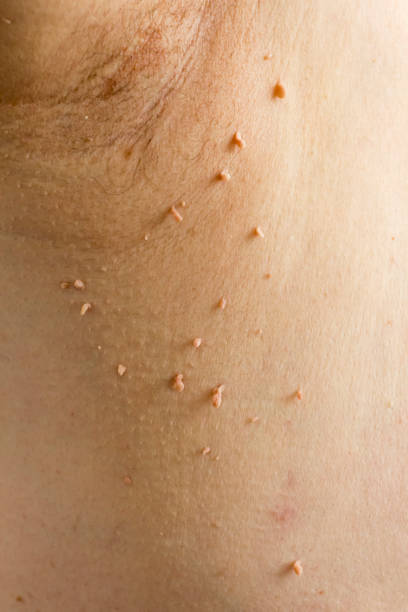
Post-Removal Care and Prevention Tips
After skin tag removal, proper care and preventive measures can help ensure optimal healing and minimize the risk of complications. Here are some essential post-removal care tips:
What to Expect After Skin Tag Removal
Following skin tag removal, it is normal to experience mild redness, swelling, or a slight scab at the removal site. These symptoms should resolve within a few days. It is crucial to keep the area clean and dry to prevent infection. Avoid picking at the scab or applying harsh chemicals or products that may irritate the healing skin.
Possible Complications and Side Effects
While skin tag removal procedures are generally safe; there are potential complications or side effects. These can include infection, bleeding, scarring, allergic reactions to anesthesia or post-removal products, and skin discoloration. To minimize these risks, it is crucial to adhere to the post-removal care instructions given by your healthcare professional. If you observe any signs of infection, like heightened pain, redness, swelling, or discharge, or if you encounter severe or prolonged side effects, seeking medical attention is imperative.
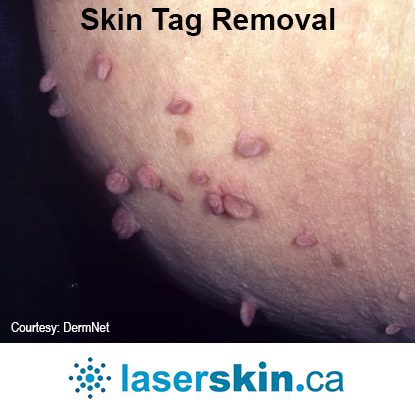
Prevention Recommendations
While preventing all skin tags may not be possible, certain measures can help reduce their occurrence. Maintaining a healthy weight, practicing good hygiene, and avoiding excessive friction or irritation to the skin can minimize the risk of developing new tags. Regular skin self-examinations can also help detect new growths or changes in existing tags, allowing for early intervention if needed.
Myths and Misconceptions About Skin Tag Removal
There are several myths and misconceptions surrounding skin tag removal. It is essential to separate fact from fiction to make informed decisions. Some common misconceptions debunked:
Removing Skin Tags Can Cause Cancer
Contrary to popular belief, removing skin tags does not cause cancer. Skin tags are benign growths with no risk of becoming cancerous lesions. However, it is important to monitor your skin for any suspicious changes and consult a healthcare professional if you notice any unusual or changing moles or lesions.
Skin Tags Are Contagious
Skin tags are not contagious and cannot be spread from person to person through direct contact. They are benign growths that develop due to various factors such as friction, hormonal changes, and genetics. However, if you have skin tags in sensitive areas or if they are causing discomfort, it is advisable to avoid sharing personal items like jewelry or clothing to prevent any potential irritation or transfer of bacteria.

Skin Tags Always Reoccur
While it is possible for new skin tags to develop over time, removing existing tags does not guarantee their recurrence. Proper preventive measures and good skin hygiene can help minimize the likelihood of new tags forming. However, suppose you are prone to developing skin tags or have a family history. In that case, monitoring your skin regularly and seeking professional advice is important.
When to Consult a Dermatologist.
While some skin tags can be safely removed at home or through OTC treatments, there are instances where it is advisable to consult a dermatologist for proper evaluation and management. Here are some situations when professional medical assistance is recommended:
Large Skin Tags
Large skin tags, particularly those over half a centimetre in size, may require medical intervention for safe and effective removal. Dermatologists have the expertise to perform appropriate procedures based on the size, location, and characteristics of the tags.
Bleeding or Painful Skin Tags
If a skin tag is bleeding, causing pain, or showing signs of infection, it is important to consult a dermatologist. These symptoms may indicate an underlying issue or require specialized care to prevent complications.
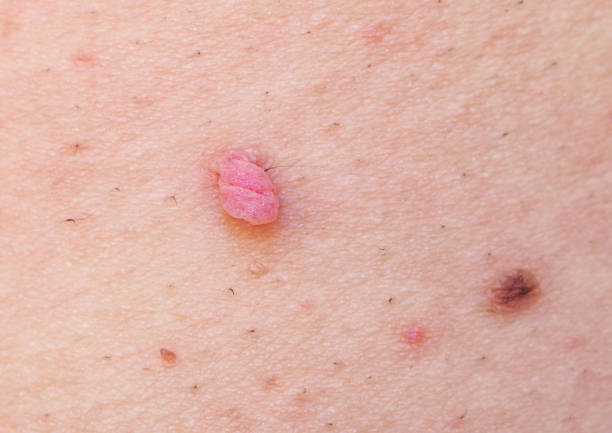
Suspicious or Irregular Skin Tags
Skin tags that exhibit unusual features such as rapid growth, changes in colour, irregular borders, or asymmetric shape should be evaluated by a dermatologist. These signs can indicate other skin conditions, including skin cancers, and require professional assessment.
Skin Tags Around the Eyes or Genitals
Skin tags around the eyes or genitals should be evaluated and treated by a dermatologist. These areas are highly sensitive, and attempting self-removal methods may pose a risk of injury or infection. A dermatologist will have the skills and tools to safely remove skin tags in these delicate regions while minimizing potential complications.
Q & A
What are skin tags?
Skin tags are common benign skin growths that appear as delicate pieces of skin hanging off the skin’s surface. They are usually flesh-coloured or slightly darker and range from a few millimetres to several centimetres. Skin tags comprise collagen fibres, blood vessels, and fat cells.
Are skin tags harmful or painful?
Skin tags are generally harmless and noncancerous. They do not cause any pain or discomfort in most cases. However, their appearance can bother some individuals, especially in visible or sensitive body areas.
Should I remove skin tags?
The decision to remove skin tags is personal and depends on individual preferences. Skin tags are generally harmless and pose no significant health risks. However, some people remove them for cosmetic reasons or if they cause discomfort, irritation, or interfere with daily activities.
What is the safest way to remove skin tags?
The safest way to remove skin tags is by consulting a board-certified dermatologist or healthcare professional. They can assess the tags, provide an accurate diagnosis, and recommend the most appropriate and safe removal method based on the tags’ size, location, and characteristics.
Are there any effective at-home remedies for skin tag removal?
Several at-home remedies are commonly used for skin tag removals, such as over-the-counter topical treatments containing salicylic acid, tea tree oil, apple cider vinegar, dental floss tying method, and certain essential oils. However, it is important to exercise caution, follow proper techniques, and be aware that scientific evidence supporting their effectiveness is limited.
Can skin tags be removed using skin tag removal bands?
Yes, skin tag removal bands are one of the methods used for removing skin tags. Placing small elastic bands tightly around the base of the skin tag is a method that cuts off its blood supply, causing the tag to shrink and eventually detach. However, seeking guidance from a healthcare professional before trying this technique is advisable.
Are there any potential hazards or complications linked to skin tag removal?
When professionals perform Skin tag removal, procedures are generally safe. However, there is a potential for risks and complications, such as infection, bleeding, scarring, and skin discoloration. It is important to follow post-removal care instructions provided by your healthcare professional to minimize these risks.
Should I be concerned if a mole changes?
Yes, any changes in a mole, such as changes in colour, size, shape, or texture, should be evaluated by a dermatologist. Although most moles are benign, alterations in moles can occasionally indicate skin cancer, specifically melanoma. Consulting a medical professional is crucial if you detect any concerning changes in a mole.
Is there a link between skin tags and certain health conditions?
Skin tags are harmless and not directly linked to specific health conditions. However, there may be associations between skin tags and factors such as obesity, hormonal changes during pregnancy or in individuals with metabolic syndrome or insulin resistance. If you have concerns about the presence of skin tags or a family history of these growths, it is recommended to seek guidance from a healthcare provider.
How can I prevent skin tags from forming?
While preventing all skin tags may not be possible, certain measures can help reduce their occurrence. Maintaining a healthy weight, practicing good hygiene, and avoiding excessive friction or irritation to the skin can minimize the risk of developing new tags. Regular self-examinations of the skin can also help detect any new growths or changes in existing tags, allowing for early intervention if needed.
Are there any medical treatments available for skin tags?
For larger skin tags located in sensitive areas or causing significant discomfort, medical procedures performed by a healthcare professional may be necessary. Some common medical methods used for skin tag removal include cryotherapy (freezing the tags), electrosurgery (burning off the tags with an electrical current), cauterization (burning off the tags with heat or chemicals), ligation (tying off the tags to cut off blood supply), and excision (surgical removal of the tags).
Can skin tags be contagious?
No, skin tags are not contagious and cannot be spread from person to person through direct contact. They are benign growths due to friction, hormonal changes, and genetics. However, suppose you have skin tags in sensitive areas or are causing discomfort. In that case, it is advisable to avoid sharing personal items like jewelry or clothing to prevent any potential irritation or transfer of bacteria.
Are any home remedies for skin tag removal supported by clinical research?
The effectiveness of home remedies for skin tag removal, such as over-the-counter or natural remedies, is often supported by anecdotal evidence and personal claims. However, scientific research and clinical studies supporting their efficacy are limited. It is important to approach these remedies cautiously and consult a healthcare professional for accurate information and guidance.
Is it necessary to consult a dermatologist for skin tag removal?
While some skin tags can be safely removed at home or through over-the-counter treatments, there are instances where it is advisable to consult a dermatologist or healthcare professional. This is particularly true for larger skin tags, tags in sensitive areas, or cases where at-home methods have been ineffective or inappropriate. Dermatologists have the expertise to perform appropriate procedures and ensure optimal results with minimal risk of complications.
What should I expect after skin tag removal?
Following skin tag removal, it is normal to experience mild redness, swelling, or a slight scab at the removal site. These symptoms should resolve within a few days. It is crucial to keep the area clean and dry to prevent infection. Avoid picking at the scab or applying harsh chemicals or products that may irritate the healing skin. If you have any concerns or experience severe or prolonged side effects, it is important to seek medical attention.
Can skin tags be a sign of an underlying health condition?
While most skin tags are harmless and not associated with specific health conditions, they may be a sign of an underlying issue in rare cases. For example, skin tags have been observed in individuals with hormonal imbalances or metabolic disorders like diabetes. If you have concerns about skin tags or a family history of these growths, it is advisable to consult a healthcare provider for a comprehensive evaluation.
Is it common to have multiple skin tags?
Yes, it is common to have multiple skin tags, especially as you age. They can develop in various body areas where the skin rubs against clothing or folds. According to estimates, over half of adults will experience the development of skin tags at some stage. However, the number and frequency of skin tags can vary from person to person.
Can skin tags be associated with weight gain?
Certain indications propose a potential link between obesity and weight gain and an elevated likelihood of developing skin tags. Excess weight can lead to increased friction and skin folds, which can contribute to the formation of skin tags. However, it is important to note that not everyone overweight will develop skin tags, and individuals of all body sizes can have them. By adhering to a well-balanced diet and engaging in regular exercise, individuals can reduce the likelihood of developing new skin tags and maintain a healthy weight.
Can skin tags be caused by clothing or pressure?
Yes, clothing and pressure can contribute to developing skin tags. Areas of the body where the skin rubs against clothing or experiences repetitive friction are more prone to developing skin tags. This is commonly observed in the neck, underarms, groin, and under the breasts. Minimizing friction and pressure in these areas, such as by wearing loose-fitting clothing or using protective barriers like bandages or powders, may help reduce the occurrence of skin tags.
Can skin tags be linked to hormonal changes?
Hormonal changes can contribute to the development of skin tags. Pregnancy, for example, is a time of significant hormonal fluctuations, and it is not uncommon for women to experience an increase in skin tags during this period. Additionally, individuals with hormonal imbalances, such as metabolic syndrome or insulin resistance, may be more susceptible to skin tag formation. However, hormonal changes alone are not the sole cause of skin tags; other factors may also play a role.
Is there a relationship between skin tags and family history?
There may be a genetic predisposition for skin tag development, as studies have shown that individuals with a family history of skin tags are more likely to have them. However, the exact mechanisms by which genetics influence skin tag formation still need to be fully understood. If you have a family history of skin tags, it may be beneficial to monitor your skin and seek professional advice if you have any concerns.
Is there a connection between skin tags and human papillomavirus (HPV)?
Skin tags are not caused by human papillomavirus (HPV). HPV is a viral infection associated with various types of genital warts. While skin tags and warts are noncancerous growths, they have different causes. Skin tags are primarily related to friction and other factors discussed earlier, while specific strains of the HPV virus cause warts.
Can contact dermatitis be mistaken for skin tags?
Contact dermatitis, an allergic reaction or skin irritation caused by contact with certain substances, can sometimes be mistaken for skin tags. Inflammation and swelling from contact dermatitis can give the appearance of a skin tag-like growth. However, contact dermatitis tends to be more temporary and often resolves once the irritant or allergen is removed. If you are still determining the nature of skin growth, it is best to consult a dermatologist for a proper evaluation.
Q: Are there any FDA-approved treatments for skin tag removal?A: The U.S. Food and Drug Administration (FDA) has not approved any specific medications or treatments specifically for the removal of skin tags
Conclusion
In conclusion, skin tag removal is a common procedure sought by individuals who wish to address cosmetic concerns or alleviate discomfort associated with these benign skin growths. While many skin tags can be safely managed at home using over-the-counter topical treatments or natural remedies, it is crucial to exercise caution and consult a healthcare professional, such as a board-certified dermatologist, for a correct diagnosis and appropriate guidance.
The effectiveness of various at-home remedies and over-the-counter products for skin tag removal is often supported by anecdotal evidence and personal claims. However, it is important to note that scientific research and clinical studies supporting their efficacy are limited.
By choosing a reputable clinic like Laser Skin Clinic | LASERSKIN.CA in Toronto, individuals can trust the expertise and specialized techniques, such as Bovie Electrocautery, to safely and effectively remove skin tags. Don’t let unwanted skin tags hold you back from feeling confident and comfortable in your own skin. Seek professional help and discover a smoother, blemish-free future.
Book Your Free Consultation Today Or Call (647) 560-9233
By providing your phone number you agree to receive informational text messages from laserskin.ca. Consent is not a condition of purchase. Message frequency will vary. Msg & data rates may apply. Reply HELP for help or STOP to cancel.
